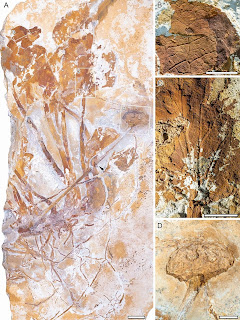 |
| Notocyamus hydrophobus Gobo, Coiffard, Bachelier, L. Kunzmann, Conceição et Iannuzzi, in Gobo, Kunzmann, Iannuzzi, Santos, Conceição, Nascimento, Silva Filho, Bachelier et Coiffard, 2023. Illustration by Rebecca Dart twitter.com/R_Dart |
Abstract
Dating back to the late Early Cretaceous, the macrofossil record of the iconic lotus family (Nelumbonaceae) is one of the oldest of flowering plants and suggests that their unmistakable leaves and nutlets embedded in large pitted receptacular fruits evolved relatively little in the 100 million years since their first known appearance. Here we describe a new fossil from the late Barremian/Aptian Crato Formation flora (NE Brazil) with both vegetative and reproductive structures, Notocyamus hydrophobus gen. nov. et sp. nov., which is now the oldest and most complete fossil record of Nelumbonaceae. In addition, it displays a unique mosaic of ancestral and derived macro- and micromorphological traits that has never been documented before in this family. This new Brazilian fossil-species also provides a rare illustration of the potential morphological and anatomical transitions experienced by Nelumbonaceae prior to a long period of relative stasis. Its potential plesiomorphic and apomorphic features shared with Proteaceae and Platanaceae not only fill a major morphological gap within Proteales but also provide new support for their unexpected relationships first suggested by molecular phylogenies.
Angiospermae Lindley (P.D.Cantino et M.J.Donoghue).
Eudicotyledoneae M.J.Donoghue, J.A.Doyle et P.D.Cantino.
Order Proteales Juss. ex Berchtold et J.Presl.
Family Nelumbonaceae A.Rich.
Notocyamus
Gobo, Coiffard, Bachelier, L.Kunzmann, Conceição et Iannuzzi, gen.nov.
Generic diagnosis: Aquatic angiosperm with herbaceous rhizomatous growth habit, with adventitious roots and long-petiolate, alternate simple leaves. Leaf with marginal petiole attachment, unlobed and untoothed margin, and distinctly papillate epidermis with anomocytic and (brachy-) paracytic stomata on both sides. Primary venation palinactinodromous, distally bifurcating, with agrophic veins. Major secondary venation festooned brochidodromous. Fruit solitary, terminal, and aggregate, derived from an apocarpous gynoecium with fruitlets embedded in an enlarged ellipsoidal receptacle, attached to a long woody peduncle. Fruitlets inserted in pits and free from the receptacle.
Etymology: Noto is derived from notos from Ancient Greek νότος (south) and cyamus from Ancient Greek κύαμος (bean), in reference to the Egyptian “bean” described by Theophrastos of Eresos, which was probably a lotus seed.
Remarks: The main diagnostic characters of Notocyamus gen. nov. are the palinactinodromous leaf venation, in which lateral primary veins branch successively rather than from one point, and the secondary xylem in the peduncle, which are distinct from any living Nelumbo or any fossil-genus in the family.
Notocyamus hydrophobus
Gobo, Coiffard, Bachelier, L. Kunzmann, Conceição et Iannuzzi, sp. nov.
Species diagnosis: Lamina noto- to mesophyllous in size with L/W ratio ca. 1, chartaceous, obovate to elliptical, with obtuse and rounded to slightly cordate base and obtuse and rounded to straight-sided apex. Interior secondaries and intersecondary veins present. Tertiary venation mixed percurrent, predominantly opposite. Quaternary venation mixed percurrent, mostly alternate. Quinternary veins regular reticulate. Areolation five- to six-sided. Freely ending veinlets absent. Marginal ultimate venation looped.
Etymology: hydrophobus is derived from Ancient Greek ὑδροφόβος meaning fearing water, in relation to the epidermis structure similar to the superhydrophobic epidermis of living lotus.
Holotype: MB.Pb. 2002/1047 (repository: Museum für Naturkunde—Leibniz Institute for Evolution and Biodiversity Science, Berlin, Germany).
Type horizon and locality: Opencast pit(s) southwest of Nova Olinda, Ceará, Brazil. Lower Cretaceous (uppermost Barremian?/lowermost Aptian), C6 limestone horizon, Crato Formation, Santana Group, Araripe Basin.
Remarks: Vegetative structures are preserved as reddish-brown replacement fossils and/or impressions with or without a thin iron oxide covering layer. Tissues of the peduncle are also replaced by iron oxide, while the receptacle is a mold with two casts of fruitlets. Clastic material is especially abundant on the rhizome of the holotype, and also in the petiole of the paratype.
 |
| Reconstruction of Notocyamus hydrophobus gen. nov. et sp. nov. in its likely environment. Illustration by Rebecca Dart (Vancouver–British Columbia). |
William Vieira Gobo, Lutz Kunzmann, Roberto Iannuzzi, Thamiris Barbosa dos Santos, Domingas Maria da Conceição, Daniel Rodrigues do Nascimento Jr., Wellington Ferreira da Silva Filho, Julien B. Bachelier and Clément Coiffard. 2023. A New Remarkable Early Cretaceous nelumbonaceous Fossil bridges the gap between herbaceous aquatic and woody protealeans. Scientific Reports. 13: 8978. DOI: 10.1038/s41598-023-33356-z

